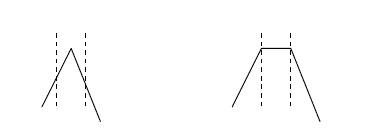
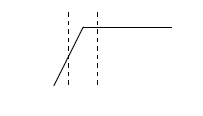
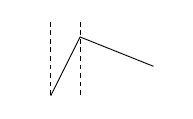
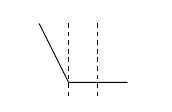
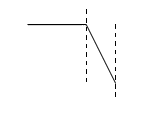
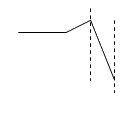

| H*, L* | pitch accent with high or low pitch target reached in the accented syllable |
| H, M, L | non-accent-lending pitch movements to the high, mid or low level |
| %H, %L | initial high or low pitch |
| %M | initial mid pitch |
| L% | final low pitch boundary (final high boundaries do not occur in Russian) |
| % | prosodic boundary not marked by pitch |
| ^ | raised peak: a small high rise, optional |
| >>> | sawtooth pattern with sequences of reduced rising or falling pitch accents |
| \/\ | single harmonica pattern |
| \/\n | repeated harmonica pattern |
Depending on the type, symbols for pitch phenomena occur as singletons or as combinations of symbols without interspacing. For example, singleton H indicates a non-accent lending pitch movement to the high level. The combination of symbols L*H indicates a type of pitch accent with a low pitch target reached in the accented syllable, immediately followed by a high pitch target; both targets L and H belong to this given pitch accent. Subsequent pitch phenomena are separated from one another by spaces. For example, H*L L% for pitch accent H*L followed by low pitch boundary L%. If no new pitch symbol appears, pitch is sustained on the last indicated level. Symbols are always indicated above the text of an utterance, exactly at the syllable on which a given pitch phenomenon is realized.
Pitch accents are marked with an asterisk (*) immediately after the pitch target that is reached in the pitch-accented syllable: H* (high) or L* (low). A pitch accent may also consist of a configuration of accent-lending pitch movements to and/or from the pitch target reached in the accented syllable, for example H*L. A symbol or combination of symbols indicating a type of pitch accent represents all realizations of that given type (see Perceptual Equivalence in the Glossary and Pronunciation Rules). In accent HL*, H indicates that pitch is high in the pretonic syllable or syllables.
The melodic context of pitch accents is further specified by indicating perceptually relevant non-accent-lending pitch movements. These movements connect pitch accents, and pitch accents and boundaries. The non-accent-lending movements preceding and following the pitch accent are indicated with the following symbols: H for rising pitch reaching a high target, L for falling pitch reaching a low target, and M for rising or falling pitch reaching a mid pitch target. Symbols are always indicated above the text of the utterance exactly at the syllable in the connecting movements where a turning point is located, that is, the point where pitch switches into another direction.
Boundaries are indicated as follows: initial pitch with %H, %L, %M, and pitch at boundaries with L% (H% does not occur in Russian). Note that %L does not necessarily indicate the lowest level of a speaker: utterances frequently start in the middle of a speaker's register. Complex initial pitch is expressed with a combination of symbols. For example, an initial non-accent-lending high fall is marked with symbols %HL. Single symbol % without pitch target indicates that there is a boundary, but that it is not marked by pitch. Initial pitch and final pitch at boundaries are indicated above the text on the utterance-initial and utterance-final syllable, respectively.
In the stylized contours below, vertical dashed lines indicate approximate boundaries of the pitch-accented syllable. The contours are stylizations and do not reflect real pitch heights. The linear distance between two boundary lines also does not refer to the actual timing of the accented syllable. It depends on the type of pitch accent where a given pitch target is reached: early or late in the accented syllable (timing), high or low in a speaker's register (excursion size, rate of change). These and other relevant features are not represented in the stylizations below, but can be found in the pronunciation rules for the respective accents.
| label | contour |
| H*L |  |
| H*H |  |
| H*M |  |
| L* |  |
| HL* |   |
| L*H |  |
On utterance-final syllables, H*H and H*L are truncated: 
In utterance-final position, no syllables follow the highest point reached in the final accented syllable, so there is no high or low posttonic pitch target.
Pauses and hesitations can occur anywhere in an utterance, that is, within an utterance or at boundaries. Speakers make pauses and hesitations if they need, for example, time to think about how to continue, to remember something, to correct an error. Pauses and hesitations can be silent or filled. If silent, there is an interruption in the speech signal: complete silence. Filled pauses and hesitations are not silent and can be of many different types, like gm 'eh'.
The optional raised peak is indicated with the symbol ^. For the convenience of the reader, in the stylized contours the raised peak is drawn with a bold line. Pitch movements occurring before the raised peak are not drawn here.

a raised peak before accents HL* (without and with a high plateau) and L*
The sawtooth pattern consists of a sequence of reduced pitch accents H*M or L* or HL*, and is indicated with symbol >>> followed by the given type of pitch accent. The reduced pitch accents have a much smaller excursion size than their full counterparts, that is, pitch in the accented syllable of reduced accents does by no means reach a target as high or as low as pitch in the accented syllable of full pitch accents (see Register and Pronunciation Rules).

sawtooth pattern with reduced H*M sawtooth pattern with reduced L* or HL*
Note that reduced pitch accents occur not only in the sawtooth pattern, but also elsewhere in utterances before main pitch accents and after main accents, for example in an afterthought.
Like the sawtooth pattern, the harmonica pattern is named after its form. Coming from the high level, usually after a raised peak, pitch accent HL* (the low target is reached late in the accented syllable) is realized, after which pitch immediately rises again. In a realization of a single harmonica, pitch accent HL* is realized after which pitch reaches the mid target; in a realization of a repeated harmonica, pitch rises after accent HL* till a level high enough to make a next raised peak (indicated in the stylization with a bold line) followed by another realization of HL*, etc. For a single harmonica, the pattern is indicated with symbol /\/, and for a repeated harmonica with symbols /\/n.

single harmonica repeated harmonica
Only main communicative functions are presented here. One pitch accent can be used to express more communicative functions and one communicative function can be expressed by more than one type of pitch accent. However, there will always be a difference in interpretation; such differences in interpretations can be very subtle. Note also that the order in which functions in the column 'other functions' are presented does not reflect the frequence of their occurrence.
| accent | label | ub | main communicative function | other communicative functions |
| H*L | rise-fall | L% | yes/no question | continuation; contrast; repeated wh-question, repeated question, alternative question; prominence (strong emphasis) in narratives and statements |
| H*H | rise-high | % | incompleteness | continuation in a closed enumeration; exclamation; positive qualification |
| H*M | rise-mid | % | incompleteness | continuation in narratives; continuation in an open enumeration; vocative: calling from a distance; meditation; puzzled reaction |
| L* | low-level | L% | completeness | neutral finality; completed sentence or paragraph; answer to a question; confirmation |
| HL* | low-fall | L% | completeness with emphasis |
emphatic answer; emphatic confirmation; wh-question with narrow focus; imperative, command; addressing someone near you |
| L*H | low-rise | % | non-first elliptic question | polemic answer; enumeration; incompleteness; imperative question |